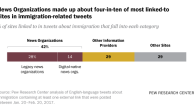Numbers, Facts and Trends Shaping Your World
News Media Trends
All
News Media Trends
Publications
-
-
short reads
Declining share of Americans would find it very hard to give up TV
Just 31% of Americans say it would be very hard to give up their TV, down from 2006. In contrast, roughly half of cellphone owners say it would be very hard to give up their cellphone.
-
report
Declining Majority of Online Adults Say the Internet Has Been Good for Society
At the same time, the contours of connectivity are shifting: One-in-five Americans (20%) are now ‘smartphone only’ internet users at home.
-
report
Americans Favor Protecting Information Freedoms Over Government Steps to Restrict False News Online
U.S. adults are mostly against government action that could limit people’s ability to access and publish information online. There is more support for steps by technology companies.
-
short reads
5 things to know about bots on Twitter
Read key findings and watch a video about our new study on how bot accounts affect the mix of content on Twitter.
-
report
Social Media Use in 2018
Facebook and YouTube dominate the social media landscape. But younger Americans, especially those ages 18 to 24, stand out in using a variety of platforms like Snapchat, Instagram and Twitter.
-
report
Sources Shared on Twitter: A Case Study on Immigration
An analysis of 9.7 million tweets reveals that news organizations played the largest role in which content was linked to in discussions about immigration compared with other information providers.
-
short reads
Many people in other countries closely follow news about the U.S.
Across 37 countries surveyed in the spring of 2017, a median of 48% say they closely follow news about the U.S., compared with 50% who do not. Interest in news about the U.S. is highest in Canada, where 78% say they track it closely. Next highest is the Netherlands (75%), followed by some of America’s closest allies: Japan, Germany and Australia. Across 10 European nations, a median of 51% say they follow news about America closely.
-
report
Publics Globally Want Unbiased News Coverage, but Are Divided on Whether Their News Media Deliver
A global median of 75% want their news media to be unbiased when covering political issues, yet many say the news media do a poor job of reporting on political issues fairly.
-
short reads
Among U.S. Latinos, the internet now rivals television as a source for news
On a typical weekday, three-quarters of U.S. Latinos get their news from internet sources, nearly equal to the share who do so from television, according to a 2016 survey of Latino adults by Pew Research Center.








